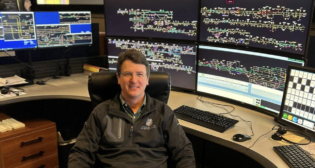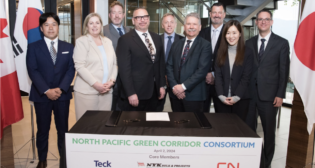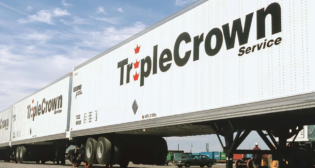
Amtrak’s Boardman: “In the final estimate, we are one industry”
Written by William C. Vantuono, Editor-in-Chief“There is a misperception that there are two kinds of railroad: a private one that hauls freight, and a public one that carries people. The reality is that our industry is a mixed collection of carriers, freight and passenger railroads, bound by agreements, arrangements, rules, and procedures, and by culture—largely an internal culture, but also by the constantly changing business and political culture in which we operate. It is our habits, beliefs, attitudes, and practices.
“Amtrak just broke its annual ridership record again, 31.6 million riders and $2.1 billion in ticket sales turning out our 10th annual record in 11 years, but it has really only been about five or six years that we began to have the ability to price manage our Northeast Corridor business. The freight railroads have found the same ability, nearly doubling their operating revenue over the course of the past decade. It is a remarkable change to be thinking and talking about capacity growth for both passenger and freight.
“This is important to us as an industry because Amtrak is a major beneficiary of the strong financial health of our host railroads, and those who depend upon Northeast Corridor access. Both freight and commuter railroads depend on Amtrak’s financial health. Over the long term we will continue to be interdependent, and carriers like Amtrak have a vital interest in a healthy and thriving freight industry.
“While our industry is changed in many respects, one of the most important parts of the story is the way that the country came back to the railroads. A lot had to happen for that transformation. Some of it has been our own investment and improvement. Some of it has been a product of the deterioration and congestion of competing modes. Some of it has been capitalizing on the advantage of being in the right place at the right time. Some of it has been exploiting our inherent efficiencies and market position to offer customers service they need. But most of it has been the hard work of the men and women who live our culture every day. It is those who gain in service to our customers more so than those who serve to gain. Those who serve only to gain have not survived the long term when the chips were down.
“The economy changed and we were in a position to exploit it—even Amtrak. Take the Northeast Corridor, for example:
“When the High Speed Ground Transportation Act passed in 1965, highway congestion was the problem, and trains were thought of as a mitigation measure. Today, trains aren’t just congestion a mitigation measure. Today at our core we move America where it wants to go. That vision has Amtrak providing mobility and ticket sales at a pace three times what all the airlines provide between New York City and Washington D.C.
“We were prepared to take advantage of opportunities that were still unforseen, and we are continually preparing with new electric locomotives now being delivered to replace our worn-out fleet of AEM-7s. Next month, we will issue a request for proposals for the next generation of high speed trains with greater capacity. Our e-ticketing initiative leads the world in revenue collection and revenue management. We need to stay on the leading edge of that technology, and we need to upgrade our technology to continue to improve information and data analysis along with safety and security for our customers and our employees.
“What will the next 40 or 50 years bring? Today, we’re always hearing about the “next big thing.” Famous corporations and institutions are melting away for various reasons, but a large number did not embrace the humility it takes to sustain themselves: collaboration, collegiality, and continuity. They perhaps did not adapt to new technologies or management methods, or they did not anticipate such huge generational attitudes changing the way they wanted to work.
“The railroad business is famously a business of institutions, Amtrak or Class I, with similar cultures. Normals are observed. Modes of conduct are long-held. Corporate loyalty and lifelong career patterns are two of those norms.
“We will have to continue to adapt, transforming our railroads into the kinds of places that generate the thinkers who will identify the next big thing and adapt us to it—perhaps said better by author Jim Collins and his work Good to Great when he spoke about two types of leaders: “The first has no intention of subjugating his ego to the needs of the common good. For these people, work will always be first and foremost about what they get—fame, fortune, adulation, power, whatever—not what they build, create, and contribute.”
“Railroading is preeminently people, and wherever you have people you have a culture. This is especially true of the railroads, where we have longevity. Cultures grow over time, hence the root word, cultura, which means cultivation or growth. As leaders, we must build, create, and contribute, and transform our organizations so that they can find more people who will build, create, and contribute—again and again and again—not just for a better railroad but for a more flexible, adaptable, and enduring business organization that also provides for the common good of the people, our nation. We want people to avoid risks at work, so they aren’t hurt. So, we aim for safe, reliable, and cautious approaches to work. But we do business in an economic environment that is often unusual and unpredictable.
“Risks are anathema to us, and at the personal safety level, they must be: We don’t run risks, we work safe. And that’s important. But you can’t run a business without risk. At Amtrak, we have worked to reconcile the conflict. We have adopted a behavioral approach to safety. We call our program “Safe-2-Safer,” and it has worked well. But it is also designed to use safety as a mechanism for developing a new generation of leaders.
“We are training employees to identify risks so that they can address them before accidents happen. Our goal is to combine safety with a proactive approach—not a reactive one. This is designed to create leaders who are comfortable with taking the initiative—and teaching them that there is not an inherent trade-off.
“As an industry, we have been through a lot in the past half-century, and it is tempting to assume we can survive whatever’s coming. Look at what lived through in the late 1960s and even during the early years following the Staggers Act. Our freight traffic is growing. Our ridership is growing. It is easy to assume that we can continue with some changes on the margins, and judicious investment. But that’s probably not a good assumption. We are going to have to transform ourselves over the next couple of decades in ways we’re only starting to perceive, as the pace of technological development continues—as does the pace of news cycles.
“Yes, the world is changing, and we must adapt our industry’s culture to the way we work now. This isn’t an Amtrak challenge or a freight railroad challenge. It’s an industry challenge, and we are all affected by the way the world is changing. I’ll give you an example.
“Crisis communication is a radically different business that it was a decade, or even five years ago. Lac-Mégantic was terrible, but the Asiana Arlines crash in San Francisco overwhelmed the media. Coverage had less to do with the relative severity than with time, place, visibility, and technology availability and user presence.
“It is amazing to see how fast some organizations respond—and how the economy punishes those who don’t. The National Transportation Safety Board posting evidence online, in real time, in a manner that informs the developing discussion, is amazing. This is a great example of successful adaptation. It’s not necessarily having that next big thing. It’s a matter of figuring out what it means, how it will affect you, and how you can adapt to it. No one person can do it. You have to create a corporate culture that allows room to innovate.
“We will have to navigate these waters together, because we depend on one another.
“The creation of a publicly funded passenger sector in 1971 was a major step toward the restoration of a healthy freight sector. The health of that passenger sector depends on the continued health of the freight carriers and the willingness of Congress to contract with Amtrak to pay the cost of long-distance trains. That is an open question for the next Amtrak bill, I believe.
“Amtrak relieved the freight carriers of a portion of their common carrier obligation, but we are also the most publicly visible component of their obligation to serve the public. That too is an open question for the industry. Will there be any future obligation on the freight railroads to renew passenger service if Congress decided to end its national contract with Amtrak?
“That bargain between passenger and freight railroads has held us together for more than four decades, and it’s a good one. Few nations are as well served by its rail systems as America is. Our service is founded on our partnership because in the final estimate, we are one industry. I believe we will rise or fall as an industry. Our problems and challenges aren’t narrowly confined to one carrier or one type of carrier. They are industry challenges.
“That’s why I’m glad to be here with you today. This conference is a good example of the kind of close and collaborative relationships we are going to need to transform the rail industry in the years to come. We will continue to have many challenges. None will be greater than the need for modern leadership, shaping and guiding our organizations and our people so that they will be adaptable.
“We must preserve what is best about our organizations, even as we look to the newest railroaders to help write the next chapter of the great history of the American railroad industry. Some of the history of the freight/passenger bargain reached in 1971 has been lost to the newer leaders coming forward on both sides of the bargain. That may mean a great deal of stress for the newest leaders as that is debated over the next year or so.”



